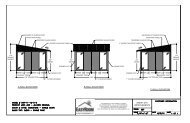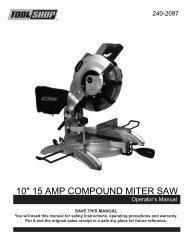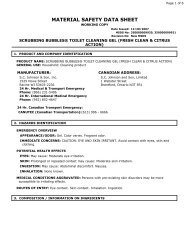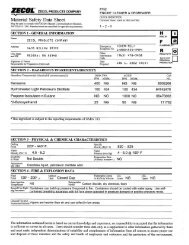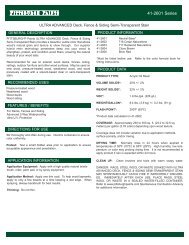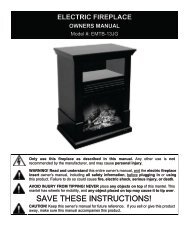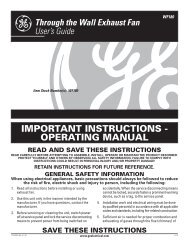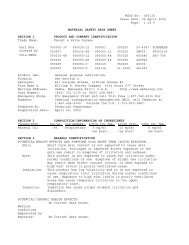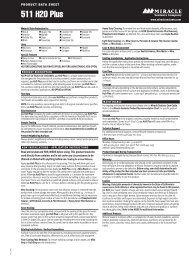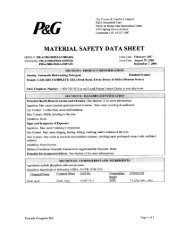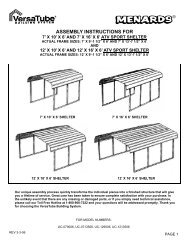WARNING - Menards
WARNING - Menards
WARNING - Menards
Create successful ePaper yourself
Turn your PDF publications into a flip-book with our unique Google optimized e-Paper software.
FEATURES<br />
• 6800 Starting Watt Output<br />
• 5500 Running Watt Output<br />
• 120 and 240 Volt AC Outputs<br />
• Low Oil Automatic Shutoff<br />
• Circuit Breaker for Overload Protection<br />
• 6.5 Gallon Fuel Tank Capacity<br />
• Spark Arrestor<br />
• Digital Hour Meter<br />
• Electric Starter<br />
• Mobility Kit included<br />
• Meets EPA Emission Standards<br />
MODEL 6800E<br />
13 HP Generator<br />
Item # 56680<br />
Owner’s Manual<br />
DO NOT RETURN TO STORE<br />
Questions? Problems?<br />
Please call our customer help line:<br />
(800) 232-1195 M-F 8-5 CST<br />
06/09
GENERATOR IDENTIFICATION<br />
For information and questions, please contact the Customer Service Help Line by calling (800) 232-<br />
1195. Certain information will be requested by the Customer Service Representative and to facilitate<br />
that, please fill in the information below.<br />
Refer to the illustration below for the location of Serial Number. Record generator information in the<br />
spaces provided below.<br />
DATE OF PURCHASE: ______________________________________________<br />
PURCHASED FROM: ______________________________________________<br />
GENERATOR MODEL NUMBER: ____________________________________<br />
ENGINE SERIAL NUMBER: _________________________________________<br />
ENGINE SERIAL NUMBER<br />
SERVICE RECORD<br />
Record Service Dates:<br />
Date<br />
Oil Change<br />
Date Date Date Date Date<br />
Change spark plug<br />
Clean Fuel Tank<br />
Clean Filter Cup<br />
Clean Air Cleaner<br />
Carburetor Maintenance<br />
i
TABLE OF CONTENTS<br />
GENERATOR IDENTIFICATION ................................................................................................i<br />
SERVICE RECORD .........................................................................................................................i<br />
INTRODUCTION ............................................................................................................................1<br />
SAFETY INFORMATION..............................................................................................................2<br />
GENERAL SAFETY PROCEDURES ...........................................................................................3<br />
IMPORTANT SAFETY INSTRUCTIONS ...................................................................................5<br />
PACKAGE CONTENTS .................................................................................................................6<br />
GENERATOR COMPONENTS.....................................................................................................8<br />
ASSEMBLY………………………………………………………………………………………..9<br />
GENERATOR PREPARATION ....................................................................................................9<br />
Using the Generator for the First Time ..........................................................................................9<br />
Step 1 - Fill Oil ...........................................................................................................................9<br />
Step 2- Add Gasoline................................................................................................................10<br />
Step 3- Ground the Generator...................................................................................................11<br />
Step 4- Connect the battery…………………………………………………………………...12<br />
STARTING THE GENERATOR .................................................................................................13<br />
SUBSEQUENT STARTING OF THE GENERATOR...............................................................15<br />
Step 1- Check the Oil................................................................................................................15<br />
Step 2 – Check the Fuel Level..................................................................................................15<br />
Step 3- Ground the Generator...................................................................................................16<br />
USING THE GENERATOR .........................................................................................................17<br />
STOPPING THE GENERATOR .................................................................................................20<br />
MAINTENANCE / CARE .............................................................................................................21<br />
Cleaning the Generator.................................................................................................................21<br />
Checking the Oil...........................................................................................................................21<br />
Changing/ Adding Oil ..................................................................................................................22<br />
Air Cleaner Maintenance..............................................................................................................23<br />
Fuel Filter Cup Cleaning ..............................................................................................................23<br />
Spark Plug Maintenance...............................................................................................................24<br />
Draining the Fuel Tank.................................................................................................................24<br />
Changing the Battery……………………………………………………………………………25<br />
STORAGE / TRANSPORT PROCEDURES ..............................................................................25<br />
SPECIFICATIONS ........................................................................................................................26<br />
TROUBLESHOOTING.................................................................................................................27<br />
EXPLODED VIEW AND PARTS LIST......................................................................................28<br />
WIRING DIAGRAM .....................................................................................................................32<br />
WARRANTY STATEMENT ........................................................................................................35<br />
ii
INTRODUCTION<br />
Thank You for Purchasing a Powerpro Technology TM Product.<br />
.<br />
This manual provides information regarding the safe operation and maintenance of this product.<br />
Every effort has been made to ensure the accuracy of the information in this manual. Powerpro<br />
Technology TM reserves the right to change this product and specifications at any time without prior<br />
notice.<br />
Please keep this manual available to all users during the entire life of the generator.<br />
Special Messages<br />
This manual contains special messages to bring attention to potential safety concerns, generator<br />
damage as well as helpful operating and servicing information. Please read all the information<br />
carefully to avoid injury and machine damage.<br />
Questions? Problems?<br />
DO NOT RETURN TO STORE<br />
Store personnel where the generator was purchased are not trained to handle technical<br />
questions or problems.<br />
In order to answer questions and solve problems in the most efficient and speedy manner,<br />
contact Customer Service at:<br />
(800) 232-1195 M-F 8-5 CST<br />
NOTICE REGARDING EMISSIONS<br />
Engines that are certified to comply with U.S. EPA emission regulations for SORE (Small Off<br />
Road Equipment), are certified to operate on regular unleaded gasoline, and may include the<br />
following emission control systems: (EM) Engine Modifications and (TWC) Three-Way Catalyst<br />
(if so equipped).<br />
1
SAFETY INFORMATION<br />
Before operating this generator read and observe all warnings, cautions, and instructions on<br />
this sheet, on the generator, and in the Owner’s Manual.<br />
NOTE: The following safety information is not meant to cover all possible conditions and<br />
situations that may occur. Read the entire Owner’s Manual for safety and operating<br />
instructions. Failure to follow instructions and safety information could result in serious<br />
injury or death.<br />
This safety alert symbol is used to identify safety information about hazards that can result in<br />
personal injury.<br />
A signal word (DANGER, <strong>WARNING</strong>, or CAUTION) is used<br />
with the alert symbol to indicate the likelihood and the potential severity of injury.<br />
In addition, a hazard symbol may be used to represent the type of hazard.<br />
DANGER indicates a hazard, which, if not avoided, will result in death or serious<br />
injury.<br />
<strong>WARNING</strong> indicates a hazard, which, if not avoided, could result in death or<br />
serious injury.<br />
CAUTION indicates a hazard, which, if not avoided, might result in minor or<br />
moderate injury.<br />
CAUTION, when used without the alert symbol, indicates a situation that could<br />
result in damage to the engine or generator.<br />
SAFETY SYMBOLS AND MEANINGS<br />
2
GENERAL SAFETY PROCEDURES<br />
For any questions regarding the hazard and safety notices listed in this manual or on the<br />
product, please call (800) 232-1195 M-F 8-5 CST before using the generator.<br />
DANGER: CARBON MONOXIDE. Using a generator indoors CAN KILL<br />
YOU IN MINUTES.<br />
Generator exhaust contains carbon monoxide (CO). This is a poison gas you<br />
cannot see or smell. If you can smell the generator exhaust, you are breathing CO.<br />
But even if you cannot smell the exhaust, you could be breathing CO.<br />
• NEVER use a generator inside homes, garages, crawlspaces, or other partly enclosed<br />
areas. Deadly levels of carbon monoxide can build up in these areas. Using a fan or<br />
opening windows and doors does NOT supply enough fresh air.<br />
• ONLY use a generator outside and far away from windows, doors, and vents. These<br />
openings can pull in generator exhaust.<br />
Even if you use a generator correctly, CO may leak into the home. ALWAYS use a batterypowered<br />
or battery-backup CO alarm in the home.<br />
If you start to feel sick, dizzy, or weak after the generator has been running, move to fresh<br />
air RIGHT AWAY. See a doctor. You may have carbon monoxide poisoning.<br />
<strong>WARNING</strong>: The exhaust from this product contains chemicals known to the<br />
State of California to cause cancer, birth defects, or other reproductive harm.<br />
<strong>WARNING</strong>: This generator may emit highly<br />
flammable and explosive gasoline vapors, which can<br />
cause severe burns or even death, if ignited. A nearby open flame can lead to<br />
explosion even if not directly in contact with gasoline.<br />
• Do not operate near open flame.<br />
• Do not smoke near generator.<br />
• Always operate on a firm, level surface.<br />
• Always turn generator off before refueling. Allow generator to cool for at least 2<br />
minutes before removing fuel cap. Loosen cap slowly to relieve pressure in tank.<br />
• Do not overfill fuel tank. Gasoline may expand during operation. Do not fill to the<br />
top of the tank. Allow for expansion.<br />
• Always check for spilled fuel before operating.<br />
• Empty fuel tank before storing or transporting the generator.<br />
• Before transporting, turn fuel valve to off and disconnect spark plug wire.<br />
3
<strong>WARNING</strong>: This generator produces powerful voltage, which can<br />
result in electrocution.<br />
• ALWAYS ground the generator before using it (see the “Ground the Generator”<br />
portion of the “GENERATOR PREPARATION” section).<br />
• Generator should only be plugged into electrical devices, either directly or with an<br />
extension cord. NEVER connect to a building electrical system without a qualified<br />
electrician. Such connections must comply with local electrical laws and codes.<br />
Failure to comply can create a back-feed, which may result in serious injury or death<br />
to utility workers.<br />
• Use a ground fault circuit interrupter (GFCI) in highly conductive areas such as<br />
metal decking or steel work. GFCIs are available in-line with some extension cords.<br />
• Do not use in rainy conditions.<br />
• Do not touch bare wires or receptacles (outlets).<br />
• Do not allow children or non-qualified persons to operate.<br />
<strong>WARNING</strong>: This generator produces heat when running. Temperatures<br />
near exhaust can exceed 150º F (65º C).<br />
• Do not touch hot surfaces. Pay attention to warning labels on the generator identifying<br />
hot parts of the machine.<br />
• Allow generator to cool down after use before touching engine or areas of the generator<br />
that become hot during use.<br />
CAUTION: Misuse of this generator can damage it or shorten its life.<br />
• Use generator only for its intended purposes.<br />
• Operate only on dry, level surfaces.<br />
• Allow generator to run for several minutes before connecting electrical devices.<br />
• Shut off and disconnect any malfunctioning devices from generator.<br />
• Do not exceed the wattage capacity of the generator by plugging in more electrical devices<br />
than the unit can handle.<br />
• Do not turn on electrical devices until after they are connected to the generator.<br />
• Turn off all connected electrical devices before stopping the generator.<br />
• Turn the engine switch to “OFF” position when the engine is not running.<br />
4
IMPORTANT SAFETY INSTRUCTIONS<br />
• SAVE THESE INSTRUCTIONS – This manual contains important instructions for<br />
Powerpro Technology 6800E generator that should be followed during installation and<br />
maintenance of the generator and battery.<br />
• Generators vibrate in normal use. During and after the use of the generator, inspect the<br />
generator as well as extension and power supply cords connected to it for damage resulting<br />
from vibration. Have damaged items repaired or replaced as necessary. Do not use plugs or<br />
cords that show signs of damage such as broken or cracked insulation or damaged blades.<br />
• For power outages, permanently installed stationary generators are better suited for<br />
providing backup power to the home. Even a properly connected portable generator can<br />
become overloaded. This may result in overheating or stressing the generator components,<br />
possibly leading to a generator failure.<br />
• <strong>WARNING</strong>: When this generator is used to supply a building wiring system:<br />
Generator must be installed by a qualified electrician and connected to a transfer switch as<br />
a separately derived system in accordance with the National Electrical Code, NFPA 70.<br />
The generator shall be connected to a transfer switch that switches all conductors other than<br />
the equipment grounding conductor. The frame of the generator shall be connected to an<br />
approved grounding electrode.<br />
5
In addition to the previous safety notices, please become familiar with the safety and hazard<br />
markings on the generator.<br />
DANGER<br />
6
PACKAGE CONTENTS<br />
Your generator comes with the items listed below. Please check to see that all of the following<br />
items are included with your generator.<br />
If there are any damaged or missing items, please call (800) 232-1195 M-F 8-5 CST for<br />
customer service. DO NOT RETURN TO STORE. Store personnel are not trained to assist<br />
with damaged or missing items.<br />
ITEM LIST<br />
L14-30 plug for connecting 240 Volt electrical devices<br />
Spark plug wrench<br />
Mobility kit<br />
Wrenches<br />
7
GENERATOR COMPONENTS<br />
Please familiarize yourself with the locations and functions of the various components and controls<br />
of your generator.<br />
(1) Choke Lever- Adjusts the amount of air let<br />
into the engine.<br />
(2) Air Cleaner- A removable, cleanable,<br />
sponge-like element that limits the amount of<br />
dirt pulled into the engine.<br />
(3) Fuel Valve- Allows fuel to enter engine.<br />
(4) Fuel Filter Cup- Traps dirt and water from<br />
fuel before it enters the engine.<br />
(5) Recoil Starter- Pull-cord for starting engine.<br />
(6) Electric start Switch- To start/stop engine.<br />
(7) Oil Fill and Dipstick- Location for checking<br />
and filling engine oil.<br />
(8) Circuit Reset Buttons- Reset buttons that<br />
protect the generator from electrical overload.<br />
8<br />
16 17<br />
(9) Ground Terminal- Connect grounding wires<br />
here to properly ground unit.<br />
(10) 120 Volt AC Duplex Receptacle - To connect<br />
electrical devices that run 120 Volt, 60 Hz, single<br />
phase, AC current, rated 20 amps<br />
(11) 120/240 Volt AC Receptacle- To connect<br />
electrical devices that run 120 and/or 240 Volt,<br />
60 Hz, single phase, AC current, twist lock<br />
receptacle, rated 30 amps.<br />
(12) Muffler with Spark Arrester- Reduces engine<br />
noise.<br />
(13) Spark Plug- Provides proper engine ignition.<br />
(14) Fuel Cap- Access to the fuel tank for adding fuel<br />
(15) Fuel Gauge- Indicates the amount of fuel in the<br />
tank.<br />
(16) Wheel<br />
(17) Handle-hold up the handle, and pull it to walk
ASSEMBLY<br />
Step 1 – Wheel Installation<br />
1. Blocking up the muffler side of the generator, assemble the axle to the frame.<br />
2. Slide the wheel and washer onto the axle, with the offset of the wheel hub against the frame.<br />
3. Secure the wheel to the axle with the cotter pin.<br />
4. Repeat above instructions for the remaining wheel.<br />
Step 2 –Foot Installation<br />
1. Blocking up the engine side of the generator, assemble the rubber foot to the frame.<br />
2. Repeat above instructions for the remaining foot.<br />
Step 3 –Handle Installation<br />
1. Assemble the handle to the frame (align with hole in tubing). Slide the bolt through handle,<br />
frame and washer and secure with the nut. Tighten until handle is securely clamped to the<br />
frame.<br />
2. Repeat above instruction for remaining handle.<br />
Using the Generator for the First Time<br />
GENERATOR PREPARATION<br />
The following section describes steps necessary to prepare the generator for use. If after<br />
reading this section, you are unsure about how to perform any of the steps please call (800)<br />
232-1195 M-F 8-5 CST for customer service. Failure to perform these steps properly can<br />
damage the generator or shorten its life.<br />
Step 1 - Fill Oil<br />
The generator is shipped without oil. User must add the proper amount of oil before operating the<br />
generator for the first time. The oil capacity of the engine crankcase is 37 fluid oz.<br />
Select good quality detergent oil bearing the American Petroleum Institute (API) service<br />
classifications SJ, SL, or SM. (Synthetic oils may be used.) Use the SAE viscosity grade<br />
9
of oil from the following chart that matches the starting temperature anticipated before<br />
the next oil changes.<br />
Figure 1- Engine oil recommendations<br />
To fill oil to the crankcase, follow these steps:<br />
1. Make sure the generator is on a level surface. Tilting the generator to assist in filling will<br />
cause oil to flow into engine areas and will cause damage. Keep generator level!<br />
2. Remove the oil filler/dipstick cap from the engine as shown in figure 2.<br />
3. Using a funnel, add the appropriate type and amount of oil into the crankcase. The<br />
crankcase is full when the oil level has reached the second thread from the lip of the<br />
opening (see figure 3).<br />
4. Check for oil leaks. Reinstall oil filler cap before starting engine.<br />
Step 2- Add Gasoline<br />
Figure 2- Unscrewing the oil cap Figure 3- filling oil<br />
<strong>WARNING</strong>: This generator may emit highly<br />
flammable and explosive gasoline vapors, which can<br />
cause severe burns or even death if ignited. A nearby<br />
open flame can lead to explosion even if not directly in contact with gasoline.<br />
• Do not operate near open flame.<br />
• Do not smoke near generator.<br />
• Always operate on a firm, level surface.<br />
• Always turn generator off before refueling. Allow generator to cool for at least 2<br />
minutes before removing fuel cap. Loosen cap slowly to relieve pressure in tank.<br />
• Do not overfill fuel tank. Gasoline may expand during operation. Do not fill to the<br />
top of the tank. Allow for expansion.<br />
• Always check for spilled fuel before operating. Clean up any spilled fuel before<br />
starting.<br />
• Empty fuel tank before storing or transporting the generator.<br />
• Before transporting, turn fuel valve to off position and disconnect spark plug wire.<br />
10
Use fresh (within 30 days from purchase), unleaded gasoline with a minimum 87 octane rating. Do<br />
not use gasoline which contains Methanol. Do not mix oil with gasoline.<br />
To add gasoline, follow these steps:<br />
1. Make sure the generator is on a level surface.<br />
2. Unscrew fuel cap and set aside (NOTE: the fuel cap may be tight and hard to unscrew).<br />
3. Slowly add unleaded gasoline to the fuel tank. Be careful not to overfill. Please refer to the<br />
chart in figure 4 for fuel capacity. The fuel gauge on the top of the generator indicates how<br />
much gasoline is in the generator fuel tank. NOTE: Do not fill the fuel tank to the very<br />
top. Gasoline will expand and spill over during use even with the fuel cap in place.<br />
4. Reinstall fuel cap and wipe off any spilled gasoline with a dry cloth.<br />
IMPORTANT:<br />
• Never use an oil/gasoline mixture.<br />
• Never use old gasoline.<br />
• Avoid letting dirt or water into the fuel tank.<br />
• Gasoline can age in the tank and make it hard to start up the generator in the future.<br />
Never store generator for extended periods of time with fuel in the tank.<br />
Step 3- Ground the Generator<br />
Model number 6800E<br />
Fuel tank 25L (6.50 gallons)<br />
capacity<br />
Figure 4- Fuel Tank Capacity<br />
<strong>WARNING</strong>: Failure to properly ground the generator can result in<br />
electrocution.<br />
Ground the generator by tightening the grounding nut against a grounding wire (see figure 5). A<br />
generally acceptable grounding wire is a No. 12 AWG (American Wire Gauge) stranded copper<br />
wire. This grounding wire should be connected at the other end to a copper or brass grounding rod<br />
that is driven into the earth. Wire and grounding rod are not included in generator contents.<br />
Grounding codes can vary by location. Please contact a local electrician to check the grounding<br />
regulations for your area.<br />
Grounding<br />
Figure 5- Grounding nut location<br />
11
Step 4 – Connect the Battery<br />
<strong>WARNING</strong>: Battery gives off explosive hydrogen gas<br />
• Keep battery away from spark, flame, or cigarette.<br />
• Do not connect or disconnect battery while generator is running.<br />
• Service or use battery only in well ventilated areas.<br />
<strong>WARNING</strong>: Battery contains sulfuric acid. Battery acid is poisonous. Tilting the<br />
generator with the battery installed can cause battery acid to spill.<br />
• Wear protective clothing and eyewear when servicing battery.<br />
• Keep out of reach of children.<br />
• Do not tilt generator with battery installed.<br />
• If battery acid gets on your skin, wash with water immediately.<br />
• If battery acid gets in your eyes, flush with water for at least 15 minutes and call a<br />
doctor immediately.<br />
If battery acid is swallowed, drink a large amount of water or milk. Then drink milk of<br />
magnesia or vegetable oil. Call a doctor immediately.<br />
The generator comes with the battery disconnected for safety. To use the electric start, the battery<br />
needs to be connected. To connect the battery:<br />
1. Remove the protective covering from the free end of the negative battery cable. This cable<br />
is connected to the generator on the other end and is located in the vicinity of the battery.<br />
2. Attach the free end of the negative cable to the battery and secure the connection.<br />
NOTE: If you do not plan to use the generator for a long period of time, it is a good idea to<br />
disconnect the negative battery cable from the battery for storage. After disconnecting the cable,<br />
cover the free end with an insulator such as electrical tape.<br />
NOTE: After completing the 4-step Generator Preparation, the generator is ready to be<br />
started.<br />
12
STARTING THE GENERATOR<br />
Before starting the generator, make sure you have read and performed the steps in the<br />
“Generator Preparation” section of this manual. If you are unsure about how to perform any<br />
of the steps in this manual please call (800) 232-1195 M-F 8-5 CST for customer service.<br />
DANGER: CARBON MONOXIDE. Using a generator indoors CAN KILL<br />
YOU IN MINUTES.<br />
Generator exhaust contains carbon monoxide (CO). This is a poison gas you<br />
cannot see or smell. If you can smell the generator exhaust, you are breathing CO.<br />
But even if you cannot smell the exhaust, you could be breathing CO.<br />
• NEVER use a generator inside homes, garages, crawlspaces, or other partly enclosed<br />
areas. Deadly levels of carbon monoxide can build up in these areas. Using a fan or<br />
opening windows and doors does NOT supply enough fresh air.<br />
• ONLY use a generator outside and far away from windows, doors, and vents. These<br />
openings can pull in generator exhaust.<br />
Even if you use a generator correctly, CO may leak into the home. ALWAYS use a batterypowered<br />
or battery-backup CO alarm in the home.<br />
If you start to feel sick, dizzy, or weak after the generator has been running, move to fresh<br />
air RIGHT AWAY. See a doctor. You may have carbon monoxide poisoning.<br />
<strong>WARNING</strong>: This generator produces powerful voltage, which can result in<br />
electrocution.<br />
• ALWAYS ground the generator before using it (see the “Ground the Generator”<br />
portion of the “GENERATOR PREPARATION” section).<br />
• Generator should only be plugged into electrical devices, either directly or with an<br />
extension cord. NEVER connect to a building electrical system without a qualified<br />
electrician. Such connections must comply with local electrical laws and codes.<br />
Failure to comply can create a back-feed, which may result in serious injury or death<br />
to utility workers.<br />
• Use a ground fault circuit interrupter (GFCI) in highly conductive areas such as<br />
metal decking or steel work. GFCIs are available in-line with some extension cords.<br />
• Do not use in rainy or wet conditions.<br />
• Do not touch bare wires or receptacles (outlets).<br />
• Do not allow children or non-qualified persons to operate.<br />
CAUTION: Disconnect all electrical loads from the generator before<br />
attempting to start.<br />
13
Electric Start<br />
To start the generator using the electric start function, perform the following steps:<br />
1. Make sure no electrical devices are connected to the generator. Such devices can make it<br />
difficult for the engine to start.<br />
2. Check that the generator is properly grounded (see Figure 5, “Ground the Generator”).<br />
3. Check the oil and gas levels.<br />
4. Turn the fuel valve to the “ON” position (see figure 6).<br />
5. Move the choke rod to the “Start” position (see figure 7).<br />
6. Set the engine switch to the “ON” position.<br />
7. Turn the engine switch to the “START” position for 2-3 seconds or until the engine starts.<br />
NOTE: If the engine does not start after 2-3 seconds, release the switch from the start<br />
position. Keeping the switch in the START position too long can damage the starter.<br />
8. If engine fails to start, wait 10 seconds, then repeat step 7. NOTE: After repeated attempts<br />
to start the engine, please consult the troubleshooting guide before attempting again. If<br />
problems persist please call (800) 232-1195 M-F 8-5 CST.<br />
9. Once the engine has started. Slowly move the choke rod all the way to the “Run” position.<br />
Allow the generator to run for several minutes before attempting to connect any electrical devices.<br />
Manual Start<br />
To start your generator using the manual start function, perform the following steps:<br />
1. No electrical devices should be connected to the generator during starting. Devices can<br />
make it difficult for the engine to start.<br />
2. Check that the generator is properly grounded (see “Ground the Generator”).<br />
3. Check the oil and fuel levels.<br />
4. Turn the fuel valve to the “ON” position (see figure 6).<br />
5. Move the choke lever to the “Start” position (see figure 7).<br />
6. Set the engine switch to the “ON” position.<br />
7. Pull on the recoil starter grip slowly until a slight resistance is felt (see figure 8). Then pull<br />
quickly to start the engine. Return cord gently into the machine. Never allow the cord to<br />
snap back.<br />
8. If engine fails to start, repeat step 7. NOTE: After repeated failed attempts to start the<br />
engine, please consult the troubleshooting guide before attempting again. If problems<br />
persist please call (800) 232-1195 M-F 8-5 CST.<br />
9. Once the engine has started. Slowly move the choke rod all the way to the “Run” position.<br />
Allow the generator to run for several minutes before attempting to connect any electrical devices.<br />
This allows the generator to stabilize its speed and temperature.<br />
14
Figure 6- Fuel Valve in the “ON” position<br />
Figure 8- Pulling the start cord<br />
Figure 7- Pull choke out for Start<br />
position. Push in for Run position.<br />
SUBSEQUENT STARTING OF THE GENERATOR<br />
If this is not the first time using the generator, user should take the following steps to prepare it for<br />
operation.<br />
IMPORTANT: At this point the user should be familiar with the procedures described in the<br />
section titled “Using the Generator for the First Time.” If the user has not yet read this<br />
section, go back and read it now.<br />
Step 1- Check the Oil<br />
Oil consumption is normal during generator usage. The generator is equipped with a low-oil<br />
shutoff to protect it from damage. The oil level in the engine should be checked before each use to<br />
ensure that the engine crankcase contains sufficient lubricant.<br />
To check or add oil, follow these steps:<br />
1. Make sure the generator is on a level surface. Clean around oil fill.<br />
2. Remove the oil filler/dipstick cap and check oil level.<br />
3. If oil level is below the second thread from the lip of the oil fill opening, slowly add oil<br />
until the engine crankcase is filled.<br />
4. Reinstall and tighten oil filler cap before starting the engine. .<br />
Step 2 – Check the Fuel Level<br />
Before starting the generator, check to see that there is sufficient gasoline in the fuel tank. The fuel<br />
gauge on top of the generator will indicate the fuel level in the tank. Add gasoline if necessary but<br />
leave sufficient room in tank for expansion.<br />
<strong>WARNING</strong>: This generator may emit highly<br />
flammable and explosive gasoline vapors, which can<br />
cause severe burns or even death if ignited. A nearby<br />
15
open flame can lead to explosion even if not directly in contact with fuel.<br />
• Do not operate near open flame.<br />
• Do not smoke near generator.<br />
• Always operate on a firm, level surface.<br />
• Always turn generator off before refueling. Allow generator to cool for at least 2<br />
minutes before removing fuel cap. Loosen cap slowly to relieve pressure in tank.<br />
• Do not overfill fuel tank. Gasoline may expand during operation. Do not fill to the<br />
top of the tank. Allow for expansion.<br />
• Always check for spilled fuel before operating. Clean up any spilled fuel before<br />
starting.<br />
• Empty fuel tank before storing or transporting the generator.<br />
• Before transporting, turn fuel valve to off and disconnect spark plug wire.<br />
IMPORTANT:<br />
• Use only UNLEADED gasoline with an octane rating of 87 or higher.<br />
• Do not use old gasoline.<br />
• Never use an oil/gasoline mixture.<br />
• Avoid letting dirt or water into the fuel tank.<br />
Step 3- Ground the Generator<br />
<strong>WARNING</strong>: Failure to properly ground the generator can result in<br />
electrocution.<br />
Ground the generator by tightening the grounding nut on the front control panel against a<br />
grounding wire. (Figure 5) A generally acceptable grounding wire is a No. 12 AWG (American<br />
Wire Gauge) stranded copper wire. This grounding wire should be connected at the other end to a<br />
copper, brass, or steel-grounding rod that is driven into the earth. Wire and grounding rod are not<br />
included in generator contents.<br />
Grounding codes can vary by location. Contact a local electrician for area codes.<br />
16
USING THE GENERATOR<br />
<strong>WARNING</strong>: When this generator is used to supply a building wiring system:<br />
Generator must be installed by a qualified electrician and connected to a transfer switch<br />
as a separately derived system in accordance with the National Electrical Code, NFPA 70.<br />
The generator shall be connected to a transfer switch that switches all conductors other than the<br />
equipment grounding conductor. The frame of the generator shall be connected to an approved<br />
grounding electrode.<br />
For power outages, permanently installed stationary generators are better suited for providing<br />
backup power to the home. Even a properly connected portable generator can become overloaded.<br />
This may result in overheating or stressing the generator components, possibly leading to a<br />
generator failure.<br />
Before connecting electrical devices, allow the generator to run for a few minutes to stabilize the<br />
speed and voltage output.<br />
CAUTION: Become familiar with the markings on the panel before connecting electrical devices.<br />
Connect electrical devices running on AC current according to their wattage requirements. The<br />
chart in figure 9 shows the running and starting wattage of your generator according to its model<br />
number.<br />
NOTE: Although the overall running wattage of the machine is 5000 Watts, it is not recommended<br />
that you attempt to draw more than 2400 Watts (20 A) from any ONE of the 120 Volt receptacles.<br />
The running wattage corresponds to the maximum wattage the generator can output on a<br />
continuous basis.<br />
The starting wattage corresponds to the maximum amount of power the generator can output for a<br />
short period of time. Many electrical devices such as refrigerators require short bursts of extra<br />
power, in addition to the running wattage listed by the device, to stop and start their motors. The<br />
starting wattage ability of the generator covers this extra power requirement.<br />
Model Number Rated(Running) Wattage Starting Watt<br />
6800E 5500 6800<br />
Figure 9- generator wattage.<br />
The total running wattage requirement of the electrical devices connected to the generator should<br />
not exceed the running wattage of the generator itself. To calculate the total wattage requirement<br />
of the electrical devices you wish to connect, find the rated (or running) wattage of each device.<br />
This number should be listed somewhere on the device or in its instruction manual. If you cannot<br />
find this wattage, you may calculate it by multiplying the Voltage requirement by the Amperage<br />
drawn:<br />
Watts= Volts x Amperes<br />
If these specifications are not available, you may estimate the Watts required by your device using<br />
the chart in figure 10.<br />
17
When the running wattage requirement of each electrical device has been determined, add these<br />
numbers to find the total running wattage needed. If this number exceeds the running wattage of<br />
the generator, DO NOT connect all these devices. Select a combination of electrical devices,<br />
which has a total running wattage lower than or equal to the running wattage of the generator.<br />
CAUTION: The generator can run at its starting wattage capacity for only a short time.<br />
Connect electrical devices requiring a rated (running) wattage equal to or less than the<br />
running wattage of the generator. Never connect devices requiring a running wattage equal<br />
to the surge wattage of the generator. This can trip the circuit protectors (circuit breakers).<br />
tool or appliance rated (running) Watts additional starting Watts<br />
electric water heater (40 gal) 4000 0<br />
hot plate 2500 0<br />
saw- radial arm 2000 2000<br />
electric stove (each element) 1500-2800 0<br />
saw- circular 1500 1500<br />
air compressor (1 HP) 1500 3000<br />
window air conditioner 1200 1800<br />
saw- miter 1200 1200<br />
microwave 1000 0<br />
well water pump 1000 1000<br />
reciprocating saw 960 1040<br />
sump pump 800 1200<br />
refrigerator freezer 800 1200<br />
furnace blower 800 1300<br />
computer 800 0<br />
electric drill 600 900<br />
television 500 0<br />
deep freezer 500 500<br />
garage door opener 480 0<br />
stereo 400 0<br />
box fan 300 600<br />
clock radio 300 0<br />
security system 180 0<br />
DVD player/ VCR 100 0<br />
common light bulb 75 0<br />
NOTE: The above wattage figures are estimates. Try to check the wattage listed on your electrical<br />
device before consulting this chart.<br />
Figure 10- Estimated wattage requirements of common electrical devices.<br />
Once you have determined what electrical devices you will be powering with the generator,<br />
connect these devices according to the following procedure:<br />
1. Plug in each electrical device with the device turned off. NOTE: Be sure to attach<br />
appliances to the correct receptacles (outlets). Connect standard 120 Volt, single phase,<br />
60 Hz loads only to the 120 Volt receptacles. Connect 120/240 Volt, single phase, 60Hz<br />
loads with a NEMA L14-30 plug only to the 120/240 Volt receptacle See Figure 11 for a<br />
depiction of each of these receptacles.<br />
18
2. Push in the circuit reset buttons to the “ON” position (NOTE: They may be pushed in<br />
already).<br />
CAUTION: Do not connect 50Hz or 3-phase loads to the generator.<br />
CIRCUIT RESET BUTTONS<br />
Figure 11- Receptacles available on the generator<br />
The circuit reset buttons help to prevent the generator from electrical overload. If your receptacle<br />
short circuits or becomes overloaded by an electrical device or devices with too great a wattage<br />
rating, the circuit protector may shut off power to the receptacle. In the event of such an overload,<br />
disconnect all electrical devices from the generator and press the circuit reset buttons. If power<br />
still does not return to the receptacle, call our customer service line.<br />
SOME NOTES ABOUT POWER CORDS<br />
Long or thin cords can drain the power provided to an electrical device by the generator. When<br />
using such cords, allow for a slightly higher running wattage requirement by the electrical device.<br />
See Figure 12 for recommended cords based on the power requirement of the electrical device.<br />
Device Requirements Max. Cord Length (ft) by Wire Gauge<br />
Amps Watts (120V) Watts (240 V) #8 wire #10 wire #12 wire #14 wire #16 wire<br />
2.5 300 600 NR 1000 600 375 250<br />
5 600 1200 NR 500 300 200 125<br />
7.5 900 1800 NR 350 200 125 100<br />
10 1200 2400 NR 250 150 100 50<br />
15 1800 3600 NR 150 100 65 NR<br />
20 2400 4800 175 125 75 50 NR<br />
25 3000 6000 150 100 60 NR NR<br />
30 3600 7200 125 65 NR NR NR<br />
40 4800 9600 90 NR NR NR NR<br />
*NR= not recommended<br />
2-120 volt duplex receptacle<br />
120/240 volt receptacle<br />
Figure 12- Maximum Extension Cord Lengths by Power Requirement<br />
19
Procedure to Stop Generator<br />
STOPPING THE GENERATOR<br />
NOTE: Stopping the motor or unplugging cords from the generator while it is supplying power<br />
to devices will possibly damage the voltage regulator and result in low or no power output until the<br />
voltage regulator is replaced.<br />
Following the stopping procedure will minimize the possibility of damaged voltage regulators.<br />
1. Turn off all electrical devices being powered by generator prior to unplugging them from<br />
the generator.<br />
2. Turn the engine switch to the off position.<br />
3. Turn the fuel valve to the off (horizontal) position.<br />
Stopping when generator is to be stored for long period of time:<br />
1. Turn off all electrical devices being powered by generator prior to unplugging them from<br />
the generator.<br />
2. Turn the fuel valve to the off (horizontal) position. Allow engine to run until it stops.<br />
3. If generator will be stored for more than 60 days, remove all fuel from the tank. Fuel<br />
removal is best accomplished by siphoning as much as is possible from the tank and then<br />
remove the fuel hose from the fuel cock, turn on the fuel valve and drain the remaining fuel<br />
from the tank.<br />
4. Disconnect the negative battery cable from the battery for storage. After disconnecting the<br />
cable, cover the free end with an insulator such as electrical tape.<br />
<strong>WARNING</strong>: Allow the generator to cool for several minutes before touching<br />
areas that become hot during use.<br />
CAUTION: Allowing gasoline to sit in the generator tank for long periods of time without<br />
use can make it difficult to start the generator in the future. Never store generator for<br />
extended periods of time with fuel in the tank.<br />
20
MAINTENANCE / CARE<br />
Proper routine maintenance of your generator will help prolong the life of your machine. Please<br />
perform maintenance checks and operations according the schedule in figure 13.<br />
If you have questions about any of the maintenance procedures listed in this manual, please<br />
call (800) 232-1195 M-F 8-5CST.<br />
CAUTION: Never perform maintenance operations while the generator is running.<br />
Recommended Maintenance Schedule<br />
first month<br />
then every<br />
20 hrs<br />
every 3<br />
months or<br />
50 hrs<br />
every 6<br />
months or<br />
100 hrs<br />
every year<br />
or 300 hrs<br />
Engine oil check level<br />
each use<br />
x<br />
replace x x<br />
Air cleaner check x<br />
clean x<br />
fuel filter cup clean x<br />
spark plug check/ clean x<br />
fuel tank check fuel level x<br />
clean x<br />
Cleaning the Generator<br />
Figure 13- Recommended maintenance schedule<br />
Never clean the generator when it is running! Never clean with a bucket of water or a hose. Water<br />
can get inside the working parts of the generator and cause a short circuit or corrosion.<br />
Always try to use the generator in a cool, dry place. If the generator becomes dirty, clean the<br />
exterior with a damp cloth, a soft brush, vacuum or pressurized air.<br />
Checking the Oil<br />
Check the oil level of the generator according to the Recommended Maintenance Schedule in<br />
Figure 13. The generator is equipped with an automatic shutoff to protect it from running with low<br />
oil pressure. The generator should be checked before each use for proper oil level. This is a<br />
critical step for proper engine starting.<br />
To check or add oil, follow these steps:<br />
1. Make sure the generator is on a level surface. Clean around oil fill.<br />
2. Remove the oil filler/dipstick cap and check oil level as shown in figure 14.<br />
3. If oil level is below the second thread from the lip of the oil fill opening, slowly add oil<br />
until the engine crankcase is filled.<br />
4. Reinstall and tighten oil filler cap before starting the engine. .<br />
21
Changing/ Adding Oil<br />
Figure 14- Checking the oil<br />
Change the oil according to the maintenance schedule in figure 13. Change the oil when the<br />
engine is warm. This will allow for complete drainage. Change oil more often if operating under<br />
heavy load or high ambient temperatures. It is also necessary to drain the oil from the crankcase if<br />
it has become contaminated with water or dirt.<br />
The oil capacity of the engine in this generator is 37 fluid oz. Add oil when the oil level is low.<br />
Drain the oil from the generator according to the following steps:<br />
1. Place a container underneath the engine to catch oil as it drains.<br />
2. Using a 10 mm hex wrench, unscrew the oil drain plug (see figure 15). Allow all the oil to<br />
drain from the engine.<br />
3. Reinstall the oil drain plug and tighten with a 10 mm hex wrench.<br />
To fill the crankcase with oil, follow these steps:<br />
1. Make sure the generator is on a level surface. Tilting the generator to assist in filling will<br />
cause oil to flow into engine areas and will cause damage. Keep generator level!<br />
2. Remove the oil filler/dipstick cap from the engine as shown in figure 14 above.<br />
3. Using a funnel, add the appropriate type and amount of oil into the crankcase. The<br />
crankcase is full when the oil level has reached the second thread from the lip of the<br />
opening (see figure 16).<br />
4. Check for oil leaks. Reinstall oil filler cap before starting engine.<br />
Figure 15- Draining oil Figure 16- Adding oil<br />
NOTE: Never dispose of used motor oil in the trash or down a drain. Please call your local<br />
recycling center or auto garage to arrange oil disposal.<br />
22
Air Cleaner Maintenance<br />
Routine maintenance of the air cleaner helps maintain proper air flow to the carburetor. Check that<br />
the air cleaner is free of excessive dirt.<br />
1. Unscrew the four bolts at the top and bottom of the air cleaner cover (see figure 17).<br />
2. Remove the sponge-like elements from the cover.<br />
3. Wipe the dirt from inside the empty air cleaner cover.<br />
4. Wash the sponge-like elements in household detergent and warm water. Allow to dry.<br />
5. Reinstall the sponge-like elements in the air cleaner casing and reinstall the cover.<br />
Fuel Filter Cup Cleaning<br />
B<br />
Figure 17- Air cleaner maintenance.<br />
The fuel filter cup is a small well underneath the fuel valve. It helps to trap dirt and water that may<br />
be in the fuel tank before it can enter the engine. To clean the fuel filter cup:<br />
1. Turn the fuel valve to the “off” position.<br />
2. Unscrew the fuel filter cup from the fuel valve using a wrench. Turn the valve toward you<br />
to unscrew (see figure 18).<br />
3. Clean the cup of all sediment using a rag or brush.<br />
4. Reinstall the fuel filter cup.<br />
Fuel Valve<br />
Fuel Filter<br />
0-RING<br />
Fuel Filter Cup<br />
Fuel Filter<br />
Figure 18- Removing the Fuel Filter Cup<br />
23<br />
Cup
Spark Plug Maintenance<br />
The spark plug is important for proper engine operation. A good spark plug should be intact, free<br />
of deposits, and properly gapped. To inspect the spark plug:<br />
1. Pull on the spark plug cap to remove it.<br />
2. Unscrew the spark plug from the generator using the spark plug wrench included with this<br />
product (see figure 19).<br />
3. Visually inspect the spark plug. If it is cracked or chipped, discard and replace with a new<br />
spark plug.<br />
4. Measure the plug gap with a gauge (see figure 20). The gap should be 0.7-0.8mm (0.028-<br />
0.031in).<br />
5. If you are re-using the spark plug, use a wire brush to clean any dirt from around the spark<br />
plug base and then re-gap the spark plug.<br />
6. Screw the spark plug back into its place on the generator using the spark plug wrench. Do<br />
not over-tighten spark plug. Recommended tightening of spark plug is ½ to ¾ of a turn<br />
after spark plug gasket contacts spark plug hole. Reinstall the spark plug cap.<br />
PLUG CAP<br />
PLUG WRENCH<br />
0.7-0.8 mm<br />
(0.028-0.031 in)<br />
Figure 19- Removing the spark plug Figure 20- Measuring the spark plug gap<br />
Spark Plug: NGK BPR6ES<br />
Draining the Fuel Tank<br />
Clean fuel tank each year or before storing the generator for extended periods of time. To drain the<br />
fuel tank and carburetor:<br />
1. Turn the fuel valve to the “OFF” position.<br />
2. Remove the fuel line between the fuel valve and carburetor. Caution: a small amount of<br />
fuel may leak from the hose during removal.<br />
3. Attach a fuel line (not included with the generator) to exposed end of the fuel valve.<br />
4. Position fuel line into an appropriate container and open the valve allowing fuel to flow<br />
into the container.<br />
5. Once fuel is drained, shut off the fuel valve.<br />
6. Start and run the engine until fuel runs out.<br />
7. Remove the fuel filter cup (see “Fuel Filter Cup Cleaning” earlier in this section).<br />
8. Empty the fuel filter cup of any fuel and clean<br />
9. Reinstall the fuel filter cup.<br />
10. Store the emptied gasoline in a suitable place.<br />
CAUTION: Do not store fuel for more than 3 months.<br />
24
Changing the Battery<br />
<strong>WARNING</strong>: Battery gives off explosive hydrogen gas<br />
• Keep battery away from spark, flame, or cigarette.<br />
• Do not connect or disconnect battery while generator is running.<br />
• Service or use battery only in well ventilated areas.<br />
<strong>WARNING</strong>: Battery contains sulfuric acid. Battery acid is poisonous. Tilting the<br />
generator with the battery installed can cause battery acid to spill.<br />
• Wear protective clothing and eyewear when servicing battery.<br />
• Keep out of reach of children.<br />
• Do not tilt generator with battery installed.<br />
If your generator will start manually (using the recoil starter pull cord) but will not start electrically<br />
(with the key), the battery may be drained. In this case, you can recharge the battery by starting<br />
the generator manually and allowing it to run for 20 minutes. However, if your battery will no<br />
longer hold a charge, you may need to replace it. To replace the battery:<br />
1. Disconnect the positive (+) and negative (-) cables from the battery.<br />
2. Remove the metal bracket that secures the battery to the generator.<br />
3. Install the replacement battery and secure to the generator with the bracket. Use a 12V<br />
battery that is 11 Ah or greater.<br />
Connect the positive and negative cables to the new battery.<br />
STORAGE / TRANSPORT PROCEDURES<br />
CAUTION: Never place any type of storage cover on the generator<br />
while it is still hot.<br />
If the generator is being stored for short periods of time (30 – 60 days), add stabilized fuel to the<br />
fuel tank until full. NOTE: Filling the tank reduces the amount of air in the tank and helps reduce<br />
deterioration of fuel. Run the engine for 2 – 3 minutes allowing stabilized fuel mixture to<br />
circulate through the carburetor.<br />
When transporting or storing the generator for extended periods of time:<br />
• Drain the fuel tank (see “Draining the Fuel Tank” in the “Maintenance” section).<br />
• Disconnect the spark plug cap from the spark plug.<br />
• Do not obstruct any ventilation openings.<br />
• Keep the generator in a cool dry area.<br />
25
Generator<br />
SPECIFICATIONS<br />
Running Wattage 5500 W<br />
Starting Wattage 6800W<br />
Rated Voltage 240V/120 V<br />
Rated Amperage 23A/46A<br />
Rated Frequency 60 Hz<br />
Phase Single<br />
Dimensions(in)<br />
without mobility kit<br />
length= 27.4 width= 21.8 height= 21.5<br />
Weight 200 lbs<br />
Engine<br />
Engine type<br />
4-stroke OHV single cylinder with forced air<br />
cooling system<br />
Ignition system non-contact transistor<br />
Displacement 390 cm 3<br />
Fuel tank capacity: 25 L (6.50 US gal.)<br />
Oil capacity 1.1 L (37 fl oz.)<br />
Run time on 50% load 11 hrs<br />
Noise rating at 22 feet<br />
74 dB idle<br />
82 dB full power<br />
Spark plug NGK BPR6ES<br />
26
TROUBLESHOOTING<br />
IMPORTANT: If trouble persists please call our customer help line at (800) 232-1195 M-F 8-5<br />
Central Time.<br />
Problem Cause Solution<br />
Engine will not<br />
start<br />
Engine runs but<br />
there is no<br />
electrical output.<br />
Generator runs but<br />
does not support<br />
all electrical<br />
devices<br />
connected.<br />
Fuel valve is turned<br />
to "OFF". Turn fuel valve to "ON" position.<br />
Choke is in “Run”<br />
position. Pull choke out.<br />
Engine is out of fuel. Add gasoline.<br />
Engine is filled with<br />
contaminated or old<br />
gasoline Change the gasoline in the engine.<br />
Spark plug is dirty. Clean spark plug.<br />
Spark plug is<br />
broken. Replace spark plug.<br />
Generator is not on<br />
level surface.<br />
Move generator to a level surface to prevent low oil shutdown<br />
from triggering.<br />
Oil is low. Add or replace oil.<br />
Air cleaner is dirty. Clean or replace air cleaner.<br />
Circuit reset button<br />
is OFF.<br />
Wait for 2 minutes and push the circuit reset button to the<br />
"ON" position.<br />
Bad connecting<br />
wires/cables. If you are using an extension cord, try a different one.<br />
Bad electrical device<br />
connected to<br />
generator. Try connecting a different device.<br />
Brush is worn. Replace the brush.<br />
Generator is<br />
overloaded.<br />
Perform these steps:<br />
1. Turn off all electrical devices.<br />
2. Unplug all electrical devices.<br />
3. Turn off generator.<br />
4. Wait several minutes.<br />
5. Restart generator.<br />
6. Try connecting fewer electrical loads to the generator.<br />
Short in one of the<br />
connected devices. Try disconnecting any faulty or short-circuited electrical loads.<br />
27
ENGINE EXPLODED VIEW AND PARTS LIST<br />
28
Item Description Qty Item Description Qty<br />
1 CYLINDER HEAD SUBASSEMBLY 1 45 GOVERNOR SPINDLE 1<br />
2 EX VALVE GUIDE 1 46 GOVERNOR SHAFT CLIP 1<br />
3 IN VALVE GUIDE 1 47 GOVERNOR SHAFT 1<br />
4 VALVE GUIDE CIRCLIP 2 48 GOVERNOR WEIGHT 3<br />
5 CYLINDER HEAD GASKET 1 49 GOVERNOR SLIDER 1<br />
6 CYLINDER HEAD COVER 1 50 OIL SEAL 1<br />
7 CYLINDER HEAD COVER GASKET 1 51 BEARING 1<br />
8 BREATHER TUBE 1 52 SHROUD 1<br />
9 BOLT ASSEMBLY 1 53 BOLT 3<br />
10 WASHER 1 54 RIGHT COVER STOPPER 1<br />
11 BOLT GASKET 1 55 CRANKSHAFT ASSEMBLY 1<br />
12 INTAKE STUD 2 56 BEARING 1<br />
13 EXHAUST STUD 2 57 KEY 1<br />
14 PIN 2 58 BALANCER WEIGHT 1<br />
15 CYLINDER HEAD BOLT 4 59 PISTON RING ASSEMBLY 1<br />
16 SPARK PLUG 1 60 PISTON 1<br />
17 CYLINDER HEAD ASSEMBLY 1 61 PISTON PIN 1<br />
18 CRANKCASE ASSEMBLY 1 62 PISTON PIN CLIP 2<br />
19 CRANKCASE 1 63 CONNECTING ROD ASSEMBLY 1<br />
20 OIL SEAL 1 64 CONNECTING ROD COVER 1<br />
21 OIL SENSOR 1 65 BOLT 2<br />
22 RUBBER PLUG 1 66 CAMSHAFT ASSEMBLY 1<br />
23 OIL PROTECTOR 1 67 SPRING 1<br />
24 BOLT 1 68 INTAKE VALVE 1<br />
25 WASHER 2 69 EXHAUST VALVE 1<br />
26 DRAIN BOLT 2 70 VALVE SPRING 2<br />
27 CLIP 1 71 EX VALVE SPRING SEAT 1<br />
28 GOVERNOR ARM 1 72 VALVE CAP 1<br />
29 WASHER 1 73 VALVE SEAL 1<br />
30 PIN 1 74 IN VALVE SPRING SEAT 1<br />
31 NUT 1 75 VALVE LIFTER 2<br />
32 WASHER 1 76 VALVE TAPPET 2<br />
33 BOLT 2 77 LIFTER GUIDE 1<br />
34 BEARING 1 78 VALVE ADJUSTING BOLT 2<br />
35 OIL SEAL 1 79 VALVE ROCKER 2<br />
36 CRANKCASE COVER ASSEMBLY 1 80 VALVE ADJUSTING NUT 2<br />
37 GASKET, CRANKCASE 1 81 VALVE LOCK NUT 2<br />
38 CAP COMP., OIL FILLER 1 82 VALVE SPRING SEAT 1<br />
39 O-RING, OIL FILLER 1 83 RECOIL STARTER COVER 1<br />
40 PIN 2 84 STARTER COIL SPRING 1<br />
41 BOLT 7 85 RECOIL STARTER REEL 1<br />
42 BEARING 1 86 GRIP 1<br />
43 GOVERNOR GEAR ASSEMBLY 1 87 RECOIL STARTER ASSEMBLY 1<br />
44 WASHER 1 88 DRIVE CAM 2<br />
29
Item Description Qty Item Description Qty<br />
89 RETURNING SPRING 2 133 FUEL LINE 1<br />
90 SPRING 1 134 WING SCREW 1<br />
91 DRIVING GUIDE 1 135 AIR CLEANER COVER 1<br />
92 GUIDE TRAY SCREW 1 136 ELEMENT 1<br />
93 BOLT 3 137 BOLT 6<br />
94 RECOIL STARTER CABLE 1 138 PLASTIC BASE 1<br />
95 HANDLE CORE 1 139 AIR CLEANER GASKET 1<br />
97 STARTING MOTOR ASSEMBLY 1 141 ATR CLEANER BRACKET 1<br />
98 BOLT 2 142 NUT 1<br />
99 SHROUD, 1 143 AIR CLEANER ASSEMBLY 1<br />
100 GUIDE PLATE 1 144 FLYWHEEL NUT 1<br />
101 BOLT 1 145 STARTER PULLEY 1<br />
102 BOLT 5 146 FAN 1<br />
103 CARBURETOR ASSEMBLY 1 147 FLYWHEEL 1<br />
104 AIR CLEANER GASKET 1 148 IGNITION COIL 1<br />
105 CARBURETOR GASKET 1 149 SPARK PLUG CAP 1<br />
106 CARBURETOR INSULATOR PLATE 1 150 HIGH TENSION WIRE 1<br />
107 INLET GASKET 1 151 BOLT 2<br />
108 THROTTLE VALVE 1 152 IGNITOR STOP ENGINE WIRE 1<br />
109 CHOKE ASSEMBLY 1 153 CHARGE COIL 1<br />
110 IDLE SPEED JET 1 154 BOLT 2<br />
111 IDLE ADJUSTING SPRING 1 155 BOLT 2<br />
112 IDLE ADJUSTING BOLT 1 156 CHARGE COIL CLAMP 1<br />
113 IDLE ADJUSTING SCREW 1 157 THROTTLE CONTROL ASSEMBLY 1<br />
114 CHOKE SUBASSEMBLY 1 158 BOLT 3<br />
115 MAIN NOZZLE 1 159 THROTTLE HANDLE BLOCK 1<br />
116 FLOAT SPRING 1 160 ADJUSTING SPRING 1<br />
117 VALVE FILLING OIL NEEDLE 1 161 SCREW 1<br />
118 JET MAIN 1 162 SMALL GOVERNOR SPRING 1<br />
119 FLOAT 1 163 GOVERNER ROD 1<br />
120 FLOAT PIN 1 164 GOVERNOR SPRING 1<br />
121 DEPOSITION CUP 1 165 REGULATING ARM 1<br />
122 WASHER 1 166 REGULATING BOLT 1<br />
123 BOLT 1 167 NUT 1<br />
124 DRAIN PLUG 1<br />
125 WASHER 1<br />
126 FLOAT GASKET 1<br />
127 SOLENOID 1<br />
128 WASHER 2<br />
129 SCREW 2<br />
130 COLLAR 4<br />
131 FUEL LINE 1<br />
132 CHECK VALVE 1<br />
30
GENERATOR EXPLODED VIEW AND PARTS LIST<br />
31
Item Description Qty Item Description Qty<br />
1 ENGINE ASSEMBLY 1 49 NUT 4<br />
2 MUFFLER ASSEMBLY 1 50 WHEEL 2<br />
3 MUFFLER SHROUD 1 51 WASHER 2<br />
4 RUBBER SEAL 1 52 COTTER PIN 2<br />
5 MUFFLER BRACKET 1 53 WHEEL ASSEMBLY 1<br />
6 BOLT 4 54 CONTROL PANEL 1<br />
7 MUFFLER SIDE GUARD 1 55 CONTROL PANELASSEMBLY 1<br />
8 BOLT 9 56 CONTROL PANEL CASE 1<br />
9 MUFFLER GUARD 1 57 BOLT 4<br />
10 EXHAUST GASKET 2 58 WIRE HARNESS 1<br />
11 NUT(M8) 2 59 SLEEVE 1<br />
12 EXHAUST PIPE 1 60 SLEEVE 1<br />
13 BOLT 2 61 SWITCH ASSEMBLY 1<br />
14 PLATE 1 62 CIRCUIT BREAKER 4<br />
15 FUEL TANK 1 63 HOUR METER 1<br />
16 FUEL TANK RUBBER 4 64 DUPLEX RECEPTACLE 2<br />
17 BUSH 4 65 120/240V RECEPTACLE 1<br />
18 WASHER 4 66 GROUNDING TERMINAL 1<br />
19 BOLT 4 67 WASHER 4<br />
20 FUEL GAUGE ASSEMBLY 1 68 WASHER 4<br />
21 FUEL GAUGE GASKET 1 69 SCREW 4<br />
22 FUEL GAUGE PLATE 1 70 ROTOR COMP 1<br />
23 SCREW 1 71 STATOR COMP 1<br />
24 FUEL FILTER 1 72 MOTOR HOUSING 1<br />
25 GAS CAP 1 73 BOLT 4<br />
26 FUEL COCK ASSEMBLY 1 74 WASHER 1<br />
27 TUBE CLIP 2 75 BOLT 1<br />
28 FUEL TUBE 1 76 VOLTAGE REGULATOR 1<br />
29 FRAME 1 77 BOLT 2<br />
30 BUTTOM RUBBER A 2 78 BRUSH ASSEMBLY 1<br />
31 NUT 4 79 BOLT 1<br />
32 NUT 4 80 END COVER 1<br />
33 BUTTOM RUBBER B 2 81 BOLT 2<br />
34 FRAM RUBBER PAD 2 82 TERMINAL 1<br />
35 BATTERY CLAMP BOLT 2 83 BOLT 2<br />
36 BATTERY CLAMP 1 84 CABLE TIE 2<br />
37 NUT 2 85 BOLT 2<br />
38 NUT 6 86 BOLT 2<br />
39 FOOT BRACKET 2 87 WASHER 2<br />
40 RUBBER FOOT 2 88 NUT 2<br />
41 BOLT 4 89 SPARK ARRESTOR 1<br />
42 BOLT 2 90 SCREW 1<br />
43 WASHER 2 91 BOLT 2<br />
44 SHAFT BODY, FRONT WHEEL 1 92 NUT 2<br />
45 AXLE 1 93 RUBBER SEAT 2<br />
46 AXLE BRACKET 2 94 HANDLE 2<br />
47 WASHER 2 95 HANDLE GRIP 2<br />
48 BOLT 4<br />
32
WIRING DIAGRAM<br />
33
NOTES:<br />
34
WARRANTY STATEMENT<br />
FOR POWERPRO TECHNOLOGY PRODUCTS<br />
PowerPro Technology generators are warranted (to the original purchaser) to be free<br />
from defects in materials and workmanship for a period of two (2) years from the date of<br />
original purchase. Generators used for commercial or for rental have a warranty period of<br />
90 days from date of original purchase. Please fill out the enclosed warranty card and mail<br />
it to Power Pro Technology along with a copy of the receipt. The information is required to<br />
process warranty claims.<br />
PowerPro Technology will repair or replace, at its discretion, any part that is proven to<br />
be defective in materials or workmanship under normal use during the two (2) year<br />
warranty period. Warranty repairs or replacements will be made without charge for parts<br />
or labor. Parts replaced during warranty repairs will be considered as part of the original<br />
product and will have the same warranty period as the original product.<br />
TO EXERCISE WARRANTY COVERAGE:<br />
Do not return to retailer! For warranty and technical support call the toll-free<br />
Customer Service Number: (800) 232-1195 and you will be informed of the nearest<br />
authorized service center. We will prearrange the repair with the center.<br />
WARRANTY COVERAGE:<br />
This warranty is conveyed to the original purchaser and is not transferable.<br />
Generators contain parts that will wear out with usage and parts that need maintenance.<br />
The warranty does not cover wear or maintenance parts. Specifically, the warranty does<br />
not cover replacement of air filter, spark plug, brush and recoil starter rope.<br />
Warranty does not extend to generators damaged or affected by accidents, neglect, misuse,<br />
contaminated fuel, unauthorized alterations, use in applications beyond product design and<br />
any other modification or abuse.<br />
PowerPro Technology is not liable for any indirect, incidental or consequential damages<br />
from the sale or use of this product. Any implied warranties are limited to two (2) years as<br />
stated in this written limited warranty. Some states do not allow limitation on the length of<br />
an implied warranty. Some states do not allow the exclusion or limitation of incidental or<br />
consequential damages. This warranty gives you the specific legal right, and you may have<br />
other rights that vary by state.<br />
35



